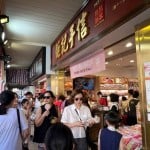As the luxury market evolves, a new generation of consumers is reshaping its landscape.
Generation Z (Gen Z), those born between 1997 and 2012, is emerging as a significant force in high-net-worth consumption.
This demographic shift is not merely about increased spending; it involves a fundamental transformation in how luxury is perceived and experienced.
Luca Deplano, director of Agility Research and Strategy, yesterday addressed these changes in a talk hosted by the France Macau Chamber of Commerce (FMCC), emphasizing the rise of “quiet luxury.”
This trend reflects a preference for understated displays of wealth and a focus on experiences rather than material possessions.
As Deplano points out, understanding the mindset of affluent consumers – especially in markets like China – is crucial for brands aiming to thrive in this new environment.
Deplano’s insights reveal China’s affluent market is experiencing substantial growth.
Despite recovering to pre-pandemic spending levels – 117% compared to 2019 – China still trails behind other regions like the U.S., which saw a 367% increase.
This discrepancy highlights a nuanced recovery, with ultra-high-net-worth individuals leading the charge in luxury spending globally.
“Nowadays, most brands have some sort of presence in China, but the Chinese consumer still enjoys traveling and shopping for luxury much more than other consumer,” said Deplano.
“Where do they go to purchase luxury goods? For the affluent Chinese, Hong Kong remains the most important destination for luxury shopping, followed by Europe,” said Deplano, adding, “Sanya [Hainan Island] ranked 4th and Macau 16th.”
Recent studies conducted with affluent Chinese consumers indicate a shift in purchasing motivations.
Initially optimistic post-Covid-19, many people of affluence now express concerns about disposable income and property investments.
The focus has shifted from displaying status to enhancing personal quality of life and enjoyment. This change underscores a broader trend where experiences are increasingly valued over traditional luxury goods.
“Fine dining and alcohol are big categories on the rise in China too, and we see a clear trend where tier one and tier two cities are holding up better than tier three cities. And this is a global phenomenon,” said Deplano.
Looking to 2025, affluent Chinese consumers are adopting a more cautious outlook regarding economic well-being.
Travel remains important, but there is a marked preference for domestic trips over international travel.
Data suggests affluent individuals are more inclined to spend on travel-related categories such as accommodation and airline tickets rather than on traditional luxury products.
Deplano’s presentation also highlighted differences in consumer behavior based on city tiers in China.
Tier one and two cities exhibit stronger economic prospects compared to tier three cities, indicating wealth accumulation and spending habits vary significantly across regions.
“Tier one cities are becoming wealthier compared to second tier and third tier cities. And that is the same also in China.”
Deplano distinguishes between affluent consumers and high-net-worth individuals.
The latter group tends to engage in exclusive activities such as country club memberships and fine dining experiences, while affluent individuals favor more accessible leisure activities. This differentiation is essential for brands aiming to target specific segments in the luxury market effectively.
The rise of Gen Z as a consumer group also brings new expectations for brands.
They prioritize authenticity, sustainability and personalized experiences over mere product ownership.
A recent survey indicated Gen Z consumers made 63% of luxury purchases, valuing how a product makes them feel rather than its price tag.
The Future of Luxury Consumption
As brands adapt to these changing dynamics, they must consider the implications of social media and digital engagement.
With Gen Z heavily influenced by platforms like TikTok, brands need to create immersive and interactive shopping experiences that resonate with this digital-native audience.
The growing interest in local Chinese luxury brands among younger generations reflects a desire for authenticity and cultural relevance.
While international brands still hold sway, local offerings are gaining traction, particularly in categories like skincare and high-end fashion. Nadia Shaw

































